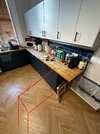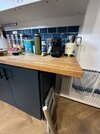- Joined
- 17 May 2021
- Messages
- 19
- Reaction score
- 0
- Country

Thinking of extending out my current wood worktops to create a small seating area/breakfast bar with a new length of worktop approx 400W and 800L and a couple of supporting legs.
From the reading I’ve done, the best way is to dry biscuit or dowel for alignment and use bolts underneath to hold.
I just want to check whether there would be possible or if there’s anything I’ve missed.
My woodworking knowledge and experience is pretty limited.
One thing I’m unsure of is how to deal with the current roundover on the section where the 90 degree joint will be.
I realise the current worktop is in poor shape but my plan was to sand everything and refinish once fitted.
From the reading I’ve done, the best way is to dry biscuit or dowel for alignment and use bolts underneath to hold.
I just want to check whether there would be possible or if there’s anything I’ve missed.
My woodworking knowledge and experience is pretty limited.
One thing I’m unsure of is how to deal with the current roundover on the section where the 90 degree joint will be.
I realise the current worktop is in poor shape but my plan was to sand everything and refinish once fitted.


